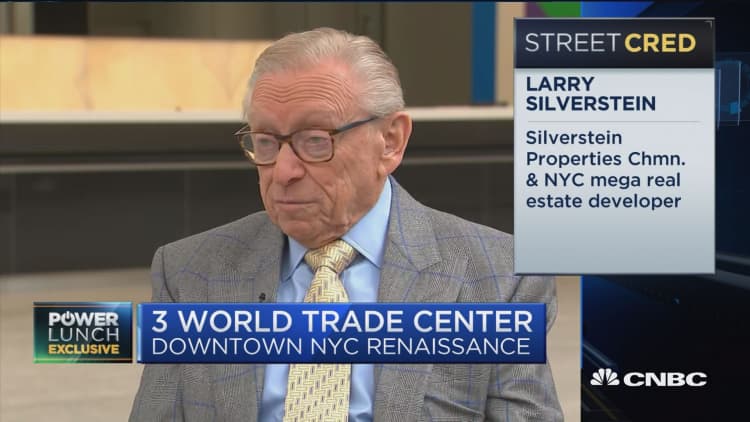
More than 16 years after the terrorist attack on the World Trade Center, a significant part of the rebuilt site is set to open.
The new building at 3 World Trade Center, which is 80 stories high and has more than 2.5 million square feet of office space, is expected to open for business on June 11.
So far, it is 40 percent occupied, but the site's developer, Larry Silverstein, is confident the building, as well as the others at the World Trade Center, will fill up.
"These buildings never stay empty for very long," he said in an interview Monday with CNBC's Sara Eisen on "Power Lunch."
Music streaming company Spotify and advertising giant WPP's GroupM are among the tenants. The newest building joins 1 and 4 World Trade Center at the site, as well as 7 World Trade Center on Greenwich Street.
The path to this point wasn't quick or easy, said Silverstein, CEO and president of the commercial real estate development firm Silverstein Properties.
In 2008, it was "extraordinarily difficult" to get mortgage financing because of the financial crisis, he said.
"It was a time when without financing, there was no way you could erect this building. But then suddenly the market started to change. It improved significantly," he recalled. "As soon as we got the financing, up the building went."
Silverstein said he sees the commercial real estate market as "strong." And he thinks that with a lot of aging office buildings in New York City, his investment will pay off.
"The truth of the matter is, today's large corporations need technology and you can only get the technology in brand-new buildings," he said.
He also isn't concerned about the effect of high taxes driving the wealthy out of the area. According to a recent Wall Street Journal op-ed by conservative economists Arthur Laffer and Stephen Moore, the new tax bill will cause a net 800,000 people to move out of New York and California over the next three years.
"There are people who will be leaving by virtue of the tax hit that they're taking due to the tax change," Silverstein said. "But I'd say the overwhelming number will probably not. Most of them will end up staying, as we've seen in previous years when issues of this nature surfaced."
So far, nearly 80 percent of the space is leased at 1 World Trade Center, while 4 World Trade Center is 100 percent leased.
The completion of this latest phase at the site comes as New York's financial district is experiencing a revival.
The commercial vacancy rate is below 10 percent and residents are also moving to the area. About 61,000 people live in the area, more than ever before.
Tourism is also booming, with nearly 14 million coming to the area in 2017 to visit Wall Street and the 9/11 Memorial.
Urban planner Alexandros Washburn, a former chief urban designer for New York City, said the renaissance since the terror attacks has been a "miracle."
"The transformation has been total," he said on "Power Lunch."
"We honestly didn't know if downtown was going to make it after 9/11. And then after the financial crash, that was more of a hit," added Washburn, a professor at Stevens Institute of Technology.
"But every time it's comes back with a better balance, more richness in the types of buildings that are here, the types of open spaces."
— CNBC's Bob Pisani and Kerima Greene contributed to this report.


